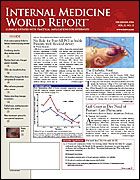Publication
Article
Internal Medicine World Report
"Window of Opportunity" for Osteoporosis Therapy Can Prevent Repeat Hip Fracture
Author(s):
PHILADELPHIA—There is a sufficient amount of time after a first hip fracture for a physician to begin osteoporosis therapy that may help prevent a second fracture, according to new data presented at the American Society for Bone and Mineral Research annual meeting.
Investigators looked at 464 patients (91 men, 373 women) who had a first hip fracture between 1948 and 2001 who were part of a population-based cohort from the Framingham Massachusetts Heart Study that enrolled a total of 5208 individuals. Patients with periprosthetic fractures or fractures due to major trauma were excluded.
Among patients with an incident hip fracture, 14% went on to experience a second hip fracture during a median follow-up of 4.4 years. Overall, 2.4% of the patients had a second hip fracture by 1 year and 7.6% had a second fracture within 5 years. Among patients who sustained 2 hip fractures, the median time between fractures was 4.7 years (range, 1 month to 33.7 years).
“There are not a lot of data right now to say that treating someone following a fracture makes a difference. Many people argue that it is too late, and there is not enough time to treat them. This study suggests that certainly the risk of dying after a hip fracture is high, but the risk of having another hip fracture is high as well. There does appear to be a sufficient amount of time between the first and second fractures for clinicians to intervene,” commented lead investigator Sarah Berry, MD, of the Beth Israel Deaconess Medical Center, Boston.
Both very low functioning persons, as measured by the Katz Activities of Daily Living scale, and very high functioning persons, as measured by the 3-item Rosow-Breslau scale, were at increased risk of a second hip fracture.
Factors that were considered clinically, but not statistically, significant included gender, body mass index, smoking status, and current estrogen use in women.
“Following a hip fracture, we need to address the possibility that individuals are going to have another fracture. At the very least, they should be getting calcium, vitamin D supplementation, and fall prevention counseling,” Dr Berry told IMWR.






